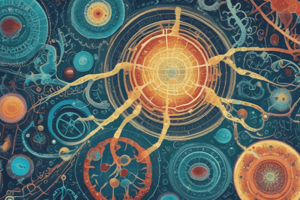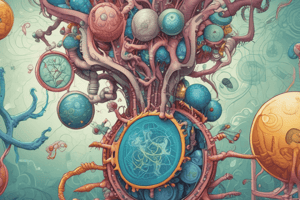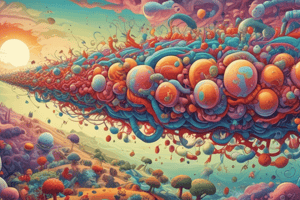Podcast
Questions and Answers
What mechanism of evolution was proposed by Charles Darwin?
What mechanism of evolution was proposed by Charles Darwin?
- Genetic drift
- Artificial selection
- Natural Selection (correct)
- Mutation theory
Which process describes the emergence of new species?
Which process describes the emergence of new species?
- Extinction
- Mutation
- Speciation (correct)
- Adaptation
What diagram represents the evolutionary relationships among species?
What diagram represents the evolutionary relationships among species?
- Food web
- Evolutionary tree (correct)
- Ecosystem map
- Population pyramid
What type of evidence suggests that all organisms share a common ancestor?
What type of evidence suggests that all organisms share a common ancestor?
What term describes large ecological areas such as tundras and rainforests?
What term describes large ecological areas such as tundras and rainforests?
Which of the following focuses on protecting biodiversity and ecosystems?
Which of the following focuses on protecting biodiversity and ecosystems?
What characterizes bacteria as microorganisms?
What characterizes bacteria as microorganisms?
Which component is NOT found in the structure of DNA?
Which component is NOT found in the structure of DNA?
How many pairs of chromosomes do humans have?
How many pairs of chromosomes do humans have?
Which of the following processes is associated with the mitochondria?
Which of the following processes is associated with the mitochondria?
What aspect of evolutionary biology focuses on the mechanisms driving species diversity?
What aspect of evolutionary biology focuses on the mechanisms driving species diversity?
Which function is primarily associated with the Golgi apparatus in a cell?
Which function is primarily associated with the Golgi apparatus in a cell?
Which technique is primarily used for modifying DNA in modern genetics?
Which technique is primarily used for modifying DNA in modern genetics?
What role do fungi play in ecosystems?
What role do fungi play in ecosystems?
Study Notes
Microbiology
- Definition: Study of microorganisms (bacteria, viruses, fungi, protozoa).
- Types of Microorganisms:
- Bacteria: Prokaryotic, single-celled organisms, can be beneficial or pathogenic.
- Viruses: Acellular, require a host to replicate, can cause diseases.
- Fungi: Eukaryotic, decomposers, include yeast and molds.
- Protozoa: Eukaryotic, single-celled, often motile, can be free-living or parasitic.
- Applications:
- Medical Microbiology: Study of pathogens and disease management.
- Industrial Microbiology: Use of microbes in fermentation, biotechnology.
- Environmental Microbiology: Role of microbes in ecosystems, bioremediation.
Genetics
- Definition: Study of heredity and genetic variation.
- Key Concepts:
- DNA Structure: Double helix, composed of nucleotides (adenine, thymine, cytosine, guanine).
- Genes: Units of heredity, segments of DNA coding for proteins.
- Chromosomes: Structures that organize DNA, humans have 23 pairs.
- Mendelian Genetics: Patterns of inheritance discovered by Gregor Mendel.
- Modern Genetics:
- Genomics: Study of the complete set of genes in an organism.
- Gene Editing: Techniques like CRISPR for modifying DNA.
Cell Biology
- Definition: Study of cell structure and function.
- Cell Types:
- Prokaryotic Cells: Simple, no nucleus (e.g., bacteria).
- Eukaryotic Cells: Complex, with nucleus (e.g., plant and animal cells).
- Cell Organelles:
- Nucleus: Contains genetic material.
- Mitochondria: Powerhouse of the cell, energy production.
- Ribosomes: Protein synthesis.
- Endoplasmic Reticulum: Protein and lipid synthesis.
- Golgi Apparatus: Modifies and packages proteins.
- Cell Cycle: Phases include interphase, mitosis, and cytokinesis.
Evolutionary Biology
- Definition: Study of the processes that drive the diversity of life.
- Key Concepts:
- Natural Selection: Mechanism of evolution proposed by Charles Darwin.
- Speciation: Process by which new species arise.
- Common Descent: All organisms share a common ancestor.
- Evolutionary Trees: Diagrams showing evolutionary relationships.
- Evidence for Evolution:
- Fossil Record: Shows changes over time.
- Comparative Anatomy: Homologous structures indicate common ancestry.
- Molecular Biology: Similarities in DNA sequences among species.
Ecology
- Definition: Study of interactions between organisms and their environment.
- Key Concepts:
- Ecosystems: Communities of living organisms interacting with their environment.
- Biomes: Large ecological areas (e.g., tundra, rainforest).
- Food Chains/Webs: Represent energy flow through ecosystems.
- Population Dynamics: Study of how populations change over time and space.
- Conservation Biology: Focus on protecting biodiversity and ecosystems.
- Human Impact: Includes habitat destruction, pollution, and climate change effects.
Microbiology
- Study of microorganisms, including bacteria, viruses, fungi, and protozoa.
- Bacteria: Prokaryotic, single-celled; can be beneficial (e.g., gut flora) or pathogenic (e.g., harmful bacteria).
- Viruses: Acellular entities that cannot replicate without a host; responsible for various diseases (e.g., influenza, COVID-19).
- Fungi: Eukaryotic decomposers; include organisms like yeast (used in baking) and molds (can cause food spoilage).
- Protozoa: Eukaryotic, single-celled organisms; can be free-living in environments (e.g., Amoeba) or parasitic (e.g., Plasmodium causing malaria).
- Applications:
- Medical Microbiology: Investigates pathogens for better disease management.
- Industrial Microbiology: Harnesses microbes in processes like fermentation for food and biofuel production.
- Environmental Microbiology: Explores microbial roles in ecosystems and bioremediation practices for pollution cleanup.
Genetics
- Study of hereditary transmission and genetic variation.
- DNA Structure: Consists of a double helix made from nucleotides: adenine (A), thymine (T), cytosine (C), and guanine (G).
- Genes: Segments of DNA that encode for proteins and define traits.
- Chromosomes: Structures containing genetic material; humans have 23 pairs, totaling 46 chromosomes.
- Mendelian Genetics: Patterns of inheritance first formulated by Gregor Mendel through pea plant experiments.
- Modern Genetics:
- Genomics: Investigates the complete genetic makeup of organisms, exploring functions and interactions.
- Gene Editing: Uses techniques like CRISPR-Cas9 to alter DNA sequences for medical and agricultural purposes.
Cell Biology
- Study of cellular structure and biological processes.
- Prokaryotic Cells: Simple and unicellular; lack a nucleus (e.g., bacteria).
- Eukaryotic Cells: More complex with a defined nucleus; includes plant and animal cells.
- Cell Organelles:
- Nucleus: Houses genetic material (DNA).
- Mitochondria: Known as the powerhouse of the cell; crucial for energy production through ATP synthesis.
- Ribosomes: Sites of protein synthesis, essential for cellular function.
- Endoplasmic Reticulum: Rough ER synthesizes proteins, while smooth ER is involved in lipid synthesis.
- Golgi Apparatus: Modifies, sorts, and packages proteins for secretion or use within the cell.
- Cell Cycle: Comprises interphase (growth phase), mitosis (cell division), and cytokinesis (cytoplasm division).
Evolutionary Biology
- Study of factors that contribute to the diversity of life on Earth.
- Natural Selection: Evolutionary process outlined by Charles Darwin, where organisms better adapted to their environment tend to survive and reproduce.
- Speciation: The creation of new species through evolutionary processes.
- Common Descent: Concept that all living organisms share a common ancestor, illustrated by evolutionary trees.
- Evidence for Evolution:
- Fossil Record: Provides chronological evidence of how species have changed over time.
- Comparative Anatomy: Identifies homologous structures as indicators of shared ancestry among species.
- Molecular Biology: Analyzes similarities in DNA sequences across different species to trace evolutionary relationships.
Ecology
- Study of interactions among organisms and their environments.
- Ecosystems: Comprised of communities of organisms interacting with abiotic elements in their surroundings.
- Biomes: Extensive ecological areas characterized by specific climate conditions and life forms (e.g., tundra, rainforest).
- Food Chains/Webs: Illustrate the flow of energy within ecosystems; food chains demonstrate direct linear paths while food webs depict complex interactions.
- Population Dynamics: Examines the factors that influence population size and composition over time and space.
- Conservation Biology: Dedicated to the protection and restoration of biodiversity and ecosystems.
- Human Impact: Discusses detrimental effects such as habitat destruction, pollution, and climate change on the environment and species.
Studying That Suits You
Use AI to generate personalized quizzes and flashcards to suit your learning preferences.
Description
This quiz covers foundational concepts in microbiology and genetics, including the types of microorganisms and their applications, as well as key genetic principles like DNA structure and heredity. Test your knowledge on both subjects and understand their significance in science.




